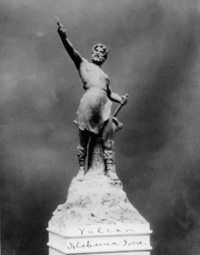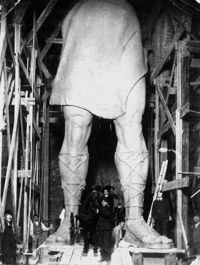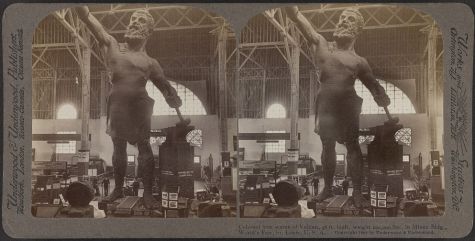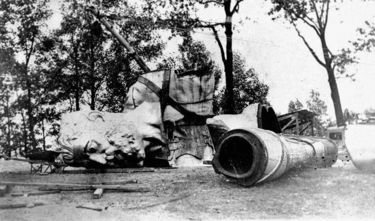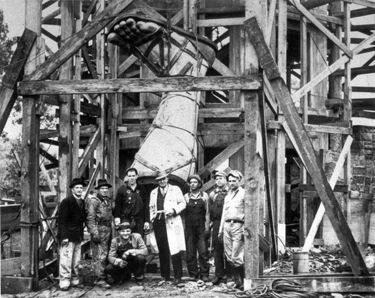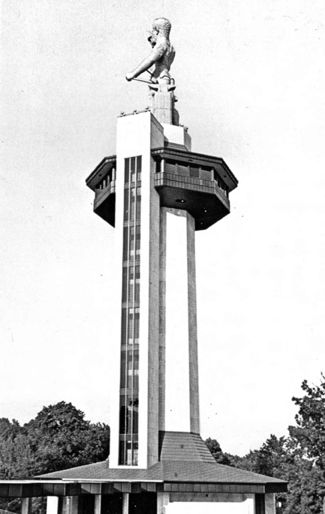Vulcan
- This article is about the Moretti statue. For other uses, see Vulcan (disambiguation).
Vulcan is the largest cast iron statue in the world and the best-known symbol of Birmingham. The 56 foot tall statue depicts Vulcan, the Roman god of the fire and forge. It was created to represent Birmingham's material resources 1904 World's Fair in St. Louis, Missouri. In 1939 it was installed as the centerpiece of Vulcan Park atop Red Mountain, near the road cut created for Montgomery Highway (map). The statue of Vulcan, along with the tower and the park grounds, underwent a significant program of restoration in 1999.
History
Conception and creation
The Commercial Club of Birmingham met in May 1903 to discuss contributing materials demonstrating the Birmingham District's mineral resources to Alabama's exhibit at the Louisiana Purchase Exhibition the next summer in St Louis, Missouri. F. Y. Anderson suggested creating large relief maps that could be donated to schools at the conclusion of the fair.
In September, the club learned that the State of Alabama was not pursuing an official exhibit for the fair. W. G. P. Harding moved that the club raise $15,000 for their own submission to promote industrial development in Birmingham. Robert Jemison, Jr seconded the motion, and the members voted in favor of the idea. James MacKnight, manager of the Alabama State Fairgrounds, proposed that instead of relief maps, the group could commission "a large figure made out of iron, steel, coal, limestone, and etc., to be about sixty feet tall," and further suggested that, "several thousand paper weights of the figure could be cast and sold to raise funds." In their October meeting the club voted to pursue MacKnight's idea, which had already been enthusiastically received by officials in St Louis, who promised to reserve an appropriate space in the Palace of Mines and Metallurgy.
A committee was formed to carry out the "giant man" project, including Fred Jackson, Rufus Rhodes, John Henry Adams, Joseph Beitman, Moses Joseph, Robert Jemison, Jr, Culpepper Exum, James McQueen, Jones Moore, Thomas Bush, Frank Dixon, Ross Smith and Frank Nelson, Jr. Rhodes devoted frequent editorials in his Birmingham News proclaiming the importance of the showing. The committee's efforts did not secure a pledge of financial support from Mayor Mel Drennen's administration, but did win a $5,000 pledge from the Jefferson County Commission and attracted dozens of new members to the Commercial Club.
In November MacKnight set out on a trip to "Boston and the East" to view monuments and interview sculptors such as C. E. Dallin. Dallin had expressed some interest in the project initially, but turned down MacKnight's offer for the commission saying that "such a statue would require two to three years to make, and—anyone who thought it could be done in less time, was off the rails." He next met with Italian-born sculptor Giuseppe Moretti, who was prepared to begin immediately. One of his earliest sketches was published alongside an article in The New York Herald before the end of the month. MacKnight reported that the sculptor was working on small figures to study the form and had already secured "a tall building at Edison's, at Jersey City" and a crew of ten men to execute the full-size plaster molds in time to cast the statue for the 1904 fair. The contract was signed, and announced in the Birmingham News on November 27.
Moretti and his assistants completed their clay master in an abandoned church in Passaic, New Jersey. The master was divided into sections and transported by rail to James McWane's Birmingham Steel and Iron Company for preparation of casting molds.
Vulcan is comprised of 29 cast iron components. The heaviest is his head, which weighs 11,000 pounds. A team of fourteen foundrymen was assembled: Fred Buettiker, Nick Smith, Charles Gustin, Jack Sarsby, Ike Swanson, Henry Veitch, Charles Zwald, Barney Conlan, Dave Williams, Charles Cason, Clarence Hancock, Henry Stapp, George Rush and one other.
The workmen designed and executed the connection details for the statue, which originally had no internal framework and was self-supporting. Any changes they made to Moretti's plaster models to accommodate their process required the artist's approval. The grey iron castings were made at the former Hood Foundry at 1st Avenue North and 14th Street in downtown Birmingham, using only from locally-produced iron. The workers toiled, working 60-hour weeks for four months, to complete the statue in time. Despite the difficulty, all the castings were successful.
1904 Exposition
Vulcan was shipped to St. Louis in pieces in early spring 1904 with the final piece arriving on April 22, eight days before the exposition commenced. However, without proper bolt holes cast to secure one of his arms, Vulcan stood at the fair incomplete through mid-May. He was finally dedicated on June 7, christened with water from the Cahaba River.
During the fair, both the phrases "Vulcan, god of fire and metals, cast at Birmingham, Alabama" and "Iron is king, its home, Birmingham, Ala." were painted in gold paint on the anvil. A dedicatory plaque included these lines, penned by John Henry Adams:
Just as my statue towers above the sons of earth, so shall the district from whose breast the ore and coal were torn and fused to give me birth, exceed all others in time's march. For o'er and o'er nature hath flung her treasures with a generous hand and Birmingham sits enthroned. Both hemispheres can draw on her; the mineral wealth of every land is there allied to rule the world in future years
Vulcan dramatically demonstrated the mineral and manufacturing riches of the Birmingham District at the Louisiana Purchase Exposition's Palace of Mines and Metallurgy, and was awarded the "Grand Prize".
After the fair ended, the popularity of the statue resulted in other cities offering to purchase it and relocate it away from Birmingham. Some of these proposals were as follows:
- St. Louis wanted to purchase it and keep it in the city after the exposition
- San Francisco wanted to purchase it and set it up somewhere in San Francisco Bay as a "counterpart" to the Statue of Liberty
- Portland, Oregon reached an agreement to have Vulcan displayed atop a newly constructed pedestal for the 1905 Louis & Clark Exposition that later fell through due to lack of funding
- Another proposal called for Vulcan to be reconstructed in the middle of Chesapeake Bay
In February 1905, the statue was finally dismantled and returned to its hometown, only to be left in pieces alongside the railroad due to unpaid freight bills. One arm was badly damaged in the move, and Vulcan's spear point was lost.
At the fairgrounds
Upon the return to Birmingham, where to locate the statue became one of the major issues of the time. Prior to settling on the location at the fairgrounds the following places were mentioned as possible locations for the statue:
- At the center of the traffic circle at Five Points South
- Atop Red Mountain
- Along 20th Street at the railroad reservation (the center of downtown)
- Within Capitol Park
After remaining disassembled along 20th Street South near Red Mountain since his return, Vulcan was reassembled at the Alabama State Fairgrounds in October 1906. The damaged arm was propped up by a heavy timber until a replacement could be cast.
With no spear to hold in his upraised hand, Vulcan soon became an advertising icon at the Fairgrounds. He held a "Weldon-Jenkins" ice cream cone, a Coca-Cola bottle, and even advertised Heinz pickles and Sherwin-Williams paints. In the late 1920s he was disassembled for inspection. During this time, children would often play around the statue's fragments. He was repainted flesh color and reassembled in the early 1930's.
In 1935 Moretti was quoted as saying "I almost wish I had never made him" in response to the way the statue was displayed and handled at the fairgrounds.
On Red Mountain
When Birmingham Kiwanis Club charter member Tom Joy returned to Birmingham after selling his successful Chicago construction business, he found his former civic league had deteriorated into "nothing but a backslapping, song-singing, weekly-lunching bunch." He challenged the Kiwanians to create and execute a plan to find a new home for the Vulcan statue.
In early 1929 he and Mercer Barnett began a campaign to place Vulcan on a more suitable pedestal. Delayed by the stock market crash, they resumed their efforts in 1934 as co-chairs of a committee organized jointly by the Kiwanis, the Birmingham City Commission and the Birmingham Park and Recreation Board.
It was not until 1936 that the statue began its move to its present home, thanks to the Works Progress Administration, which partially funded a new park on five acres donated by the Tennessee Coal, Iron and Railroad Company at the top of Red Mountain.
After evaluating proposed designs from various architects, including one by Warren Knight and Davis, a park plan was drawn up by R. S. Marshall, superintendent of the Birmingham Parks & Recreation Department. A 126-foot pedestal was built with a reinforced concrete frame, filled in with local sandstone. Vulcan, sporting a new coat of bright aluminum paint, was hoisted onto a thick concrete cap on top. A new spear was fabricated to be held high in his right hand while his left hand held a hammer at his side. Leading down the hill from the south side of the tower were two flights of stone steps, divided by a "cascade" of terraced pools planted with lilies. Plans for neon lighting to illuminate his spear and hammer were shelved.
A nine day celebration commenced on May 7, 1939 to dedicate Vulcan Park. Miss Evelyn Tully was crowned "Miss Vulcan". Guests of honor included the original foundrymen who cast Vulcan. A crowd of 5,000 was present for the opening night of the festival.
To take full advantage of Vulcan's position overlooking Birmingham, the city's Junior Chamber of Commerce in 1946 made the statue into a symbol for road safety. His spear was replaced by a neon torch that glowed green, except during the 24 hours following a fatal traffic accident, when it glowed red. The traffic safety light was first lit at a dedication ceremony on October 23, 1946. For the week of February 17–24, 1963 the torch was turned red for heart disease deaths rather than traffic fatalities as a show of support for the Heart Fund Drive.
In 1949, Vulcan found some new neighbors, when two television stations, WAFM-TV (now WVTM) and WBRC 6 located their studios and towers in "Radio Park" adjoining Vulcan Park on Red Mountain.
1959 repairs
For a month in 1959 the statue's pedestal was closed to climbers as a repair project was completed. Though an engineer's report on the condition of the structure was generally favorable, the Park & Recreation Board was determined not to leave even a 1 in 1000 chance that anyone would be injured while visiting the monument. Architect Arnold Largin drew up plans for new steel supports for the observation platform and repairs to the stairway inside the tower. The cost of the repairs was estimated at about $8,500.
Centennial facelift
To celebrate Birmingham's centennial, the area around the statue was given a $1 million facelift between 1969 and 1971. The original tower was clad in Alabama marble with an elevator and observation deck added. A covered walkway also connected a gift shop and snack bar. Vulcan was repainted a rust red a few years later. The park was rededicated on April 8, 1972.
Vulcan was listed on the National Register of Historic Places on July 6, 1976.
Unfortunately, the statue itself had, at some point, been filled up to the chest with concrete and had begun to deteriorate seriously. By 1990, an engineering study found that the statue was in danger of collapse.
1999-2004 restoration
Vulcan was removed during October and November of 1999 in preparations for a $14 million renovation process that saw the park and pedestal restored to its original 1938 appearance. The statue sat in Vulcan Park's parking lot until the fall of 2001, when it was shipped to Robinson Iron in Alexander City to be repaired. The statue itself was thoroughly inspected and repaired, with some parts, including the lost spear point, re-cast. The new and restored pieces were coated with a thick, durable finish, topped with a light gray, dubbed "Vulcan gray" by the paint consultant who supplied the specification.
Meanwhile in 2002, the 1971 additions to the park were demolished, and scaffolding went up around Vulcan's tower. Brice Building Company served as general contractor with crews from Masonry Arts doing the masonry work to clean and repair the original tower. Vulcan's head and right arm went on display at the Birmingham Museum of Art while the tower was prepared.
Vulcan was re-erected on a steel armature atop his tower during June 2003, restored to its original appearance as intended by Moretti, and slightly reoriented to the east. WVTM and WBRC both provided live webcams of the installation process.
Shortly after the statue was reinstalled, the scaffolding came down, and a new observation deck providing panoramic views of downtown Birmingham, Red Mountain, and Homewood was installed. The original museum space surrounding the base was rebuilt, though it now serves as a storage area. A new elevator was installed, oriented so it would not be easily seen from downtown Birmingham. The original waterfalls were not rebuilt, though the stone walkways leading from the parking lot directly to Vulcan's tower were restored.
In 2006 the restoration was given an Honor Award by the National Trust for Historic Preservation. $1.5 million of the restoration cost was included in the 2001 Interior Department Appropriations Bill (passed in 2000) at the request of Senator Richard Shelby. The use of federal funds for the project was criticized by Senator John McCain of Arizona who introduced an amendment to block the measure. The full Senate overrode the block by a vote of 87-12. McCain continued to use the measure as an example of egregious "pork" spending during his 2008 presidential campaign.
Vulcan Park
Vulcan Park is the 10-acre urban green space surrounding the statue. A new visitor's center, called the Vulcan Center, features interactive exhibits and displays that give insight into the region's history and the industrial growth of the Birmingham District. It also tells Vulcan's story and has a full-size replica of Vulcan's foot, that was cast in fiberglass in 1991, giving visitors a better sense of the statue's size.
In January 2008 Vulcan Park and Museum unveiled a gray plush-suited Vulcan mascot to promote park activities and tourism and to assist with educational outreach.
Trivia
- In June 1926, The Birmingham Post ran a daily column by "Dr. B. U. L. Conner" describing a mythical love affair between Vulcan and the statue of Electra atop the 1925 Alabama Power Building.
- From the 1940s to the 1970s (at least), The Birmingham News ran a regular column called "From Where I Stand". Although written by various staff members, it was always signed as being by "Ol' Vulc".
- The statue's naked buttocks are a well-known source of humor, inspiring Jack Voorhies' 1982 novelty song, "Moon Over Homewood."
- Birmingham's World Football League team, the Birmingham Vulcans were named for the statue.
- President George W. Bush's foreign policy advisory team, led by Condoleezza Rice was nicknamed "The Vulcans".
- The student-run historical journal at UAB is the Vulcan Historical Review.
- See also List of companies named after Vulcan.
References
- "Art: Iron Man" (August 17, 1936) TIME magazine
- "Vulcan to take vacation" (June 1959) The Birmingham News
- "Vulcan statue." Wikipedia, The Free Encyclopedia. 20 Mar 2006, 00:29 UTC. 20 Mar 2006, 00:31 [1].
- Morris, Philip A. (1995) Vulcan and His Times. Birmingham: Birmingham Historical Society.
- Howell, J. Scott (2004) "Bringing Back the Magic: Restoring Giuseppe Moretti's Vulcan in Birmingham, Alabama." APT Bulletin: The Journal of Preservation Technology. Volume XXXV, No. 2-3. ISSN 00449466
- Library of Congress page about the Vulcan statue, accessed November 7, 2006.
- Firestone, David (July 9, 2001) "Ailing Statue: Symbol of Industry or Pork Barrel?" The New York Times
- Knight, Shirley Bridges (2002) "The Man Who Hand-Curled Vulcan's Beard" in The Heritage of Jefferson County, Alabama. Clanton: Heritage Publishing Consultants. ISBN 1891647547
- Dean, Charles J. (April 24, 2008) "GOP candidate McCain OK with funding for Gee's Bend ferry, assails that for Vulcan." The Birmingham News
- "The Vulcans." Wikipedia, The Free Encyclopedia [2]
- "Two credited with Vulcan renaissance" (n.d.) clipping in the Birmingham Public Library archives - accessed May 21, 2008
External links
- Vulcan Park Foundation
- Vulcan photo archives at the Birmingham Public Library
- Vulcan restoration project site at Robinson Iron
- Gallery of Vulcan photos at Flickr.com
- 3-D model of Vulcan statue and pedestal by Jordan Herring

